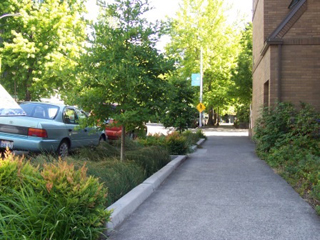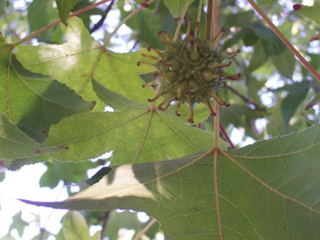Human Flower Project
Friday, October 12, 2007
Bringing City Trees to Fruition
Urban forester Georgia Silvera Seamans proposes a novel idea—helping city trees flower, fruit, reseed, and grow, rather than programmatically killing them off. For more of such enlightened ideas, visit Georgia’s fine local ecology.

SW 12th Avenue Green Street, Portland, OR
All Photos: Georgia Silvera Seamans
By Georgia Silvera Seamans
“What are flowers for?” asks Harold William Pickett. Answering himself, he writes, “All the organization of a flower seems to be directed towards the transfer of pollen from stamen to pistil, a prelude to the formation of seed.”
Unlike the forest, the network of street trees does not rely on the flowering process to reproduce. Instead, people – arborists, urban foresters, residents – purchase trees from nurseries, often located in less urban areas, and plant them in the grassy spaces between curbs and sidewalks or even within concrete sidewalks. If trees must be removed because of declining health, hazard or damage through acts of vandalism or unaware drivers, they are simply replanted with new nursery stock.

Crataegus (Hawthorne) flower, Blake Street, Berkeley, CA
Even so, flowering and fruiting do occur. I remember streets and neighborhoods by the trees they host. I recall the exuberant flowering of Tilias along Melnea Cass Boulevard and the showy flowering of Pyrus calleryana on Garrison Street in the South End, both in Boston, the apricot-colored fruit of Ginkgo biloba in Boston’s Public Garden, the swinging fruits of Liquidambar styraciflua at the North Berkeley train station and Platanus on Telegraph Avenue in Oakland.
 Liquidambar styraciflua (sweetgum) fruit, Carleton Street, Berkeley, CA
Liquidambar styraciflua (sweetgum) fruit, Carleton Street, Berkeley, CA
Yet, city trees rarely come fully to fruition. On the street, unfavorable conditions like soil compaction, poor soil quality, and inconsistent moisture levels hinder the development of seeds, not to mention the stretches of impervious concrete or metal grates covering the tree wells. Along tree boulevards (or even the grassy areas between the curb and the sidewalk), cultural practices like mowing remove seedlings, too.
The announcement of tree canopy goals by some cities—100,000 trees in Boston by 2020, 1 million trees in New York City by 2017— are more than commendable in a time of climate crisis, but, surprisingly, none of these campaigns – to my knowledge – mentions strategies to enable reproduction of street trees. To my thinking, a sustainable urban canopy should include in situ reproduction, not just replacement of trees with more nursery stock. Of course, in situ reproduction would be difficult to achieve in many of the settings where street trees are now planted. However, changing how we plant and maintain street trees – and especially how we design city sidewalks—could provide more favorable conditions for in situ reproduction.
 Shotwell Street Greenway (permeable landscape project), San Francisco, CA
Shotwell Street Greenway (permeable landscape project), San Francisco, CA
Three American cities – Seattle, Portland, and San Francisco – have developed streetscapes which “mimic the forest floor” according to articles in Terrain and Landscape Architecture Magazine; at least Seattle’s program, known as SEA (street edge alternative), was designed with that intention. Portland hosts several “green streets,” and a San Francisco nonprofit, Plant*SF, has transformed the sidewalks of a standard city block into a permeable landscape. Each of the projects was developed to capture and cleanse stormwater runoff before it enters the municipal storm system and, eventually, natural water bodies. And each project has both reduced impervious sidewalk surfaces, thus increasing the growing area, and incorporated low to mid-layer vegetation to maintain soil health. This change in streetscape design – from individual tree wells to more continuous planting areas – is significant. But it is too early to know if such new practices of city landscape maintenance will make way for other forest floor processes: if seeds will be allowed to sprout and compete for light, water, and height!




